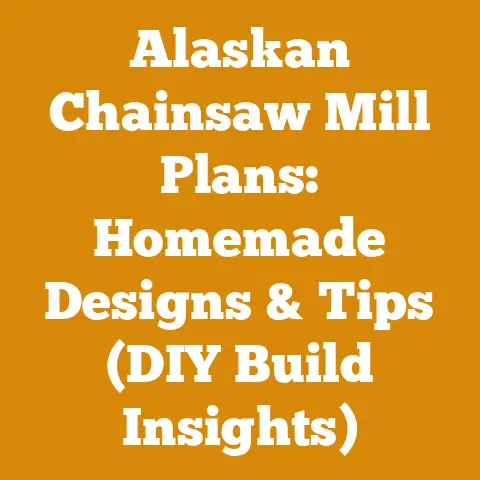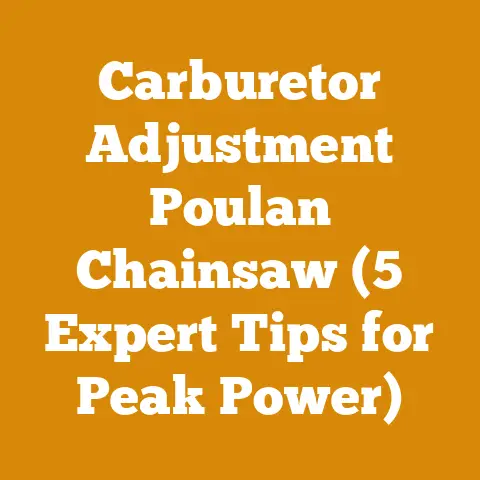When to Replace a Chainsaw Bar (5 Key Woodcutting Signs)
When I first started working with wood, my focus was solely on getting the job done. I didn’t pay much attention to the condition of my tools, especially the chainsaw bar. It wasn’t until I experienced a few close calls and realized the importance of proper maintenance that I started to understand the critical role the chainsaw bar plays in safe and efficient woodcutting.
I remember one particularly frustrating afternoon when I was trying to fell a seasoned oak. The saw kept binding, the cuts were uneven, and the whole process was taking far longer than it should have. It turned out that my chainsaw bar was severely worn, causing the chain to wobble and lose its cutting efficiency. That experience taught me a valuable lesson: a well-maintained chainsaw bar is essential for safety, efficiency, and the overall quality of your work.
This guide is designed to help you understand when to replace your chainsaw bar. I’ll share my experiences, insights, and practical tips to help you identify the key signs of wear and make informed decisions about when it’s time for a new bar. Let’s dive in!
When to Replace a Chainsaw Bar (5 Key Woodcutting Signs)
The chainsaw bar is the backbone of your cutting operation. It guides the chain, supports the cutting force, and ensures smooth, accurate cuts. Recognizing the signs of wear and knowing when to replace your bar is crucial for safety, efficiency, and prolonging the life of your chainsaw.
1. Excessive Wear on the Rails
The rails of the chainsaw bar are the edges that guide the chain. Over time, these rails can wear down due to friction and constant contact with the chain.
Identifying Rail Wear
- Visual Inspection: Examine the rails closely. Look for grooves, uneven surfaces, or a noticeable reduction in their height. A healthy rail should be smooth and uniform.
- Measurement: Use a caliper to measure the height of the rails at different points along the bar. Compare these measurements to the manufacturer’s specifications. A significant difference indicates excessive wear.
- Chain Fit: A worn bar will often cause the chain to fit loosely or wobble. If you notice that the chain is not sitting snugly in the bar groove, it’s a sign that the rails are worn.
The Impact of Worn Rails
Worn rails can lead to several problems:
- Chain Wobble: This reduces cutting accuracy and increases the risk of kickback.
- Increased Friction: This causes the saw to work harder, reducing efficiency and potentially overheating the engine.
- Uneven Cuts: The saw may cut at an angle, making it difficult to achieve clean, straight cuts.
Personal Experience
I once tried to salvage a chainsaw bar with worn rails by filing them down to create a smoother surface. While this temporarily improved the chain fit, it significantly reduced the bar’s overall lifespan and made it more prone to bending. It’s generally better to replace a bar with excessively worn rails.
Takeaway
Regularly inspect the rails of your chainsaw bar for wear. If you notice significant grooves, uneven surfaces, or a loose chain fit, it’s time to consider a replacement.
2. Damage to the Bar Body
The body of the chainsaw bar can suffer damage from various sources, including impacts, bending, and corrosion.
Types of Bar Body Damage
- Bending: This can occur if the saw is subjected to excessive force or if it gets caught in a bind.
- Cracks: These can develop from stress or impact, especially near the mounting holes or sprocket nose.
- Corrosion: Rust and corrosion can weaken the bar and affect its performance.
- Delamination: This is when the layers of steel that make up the bar separate, weakening its structural integrity.
Identifying Bar Body Damage
- Visual Inspection: Look for any signs of bending, cracks, or corrosion. Pay close attention to the areas around the mounting holes and sprocket nose.
- Straightness Test: Place the bar on a flat surface and check for any gaps or bends. A straight bar should lie flush against the surface.
- Sound Test: Tap the bar with a metal object and listen for a clear, ringing sound. A dull or muffled sound can indicate internal cracks or delamination.
The Impact of Bar Body Damage
Damage to the bar body can compromise its structural integrity and lead to:
- Increased Risk of Failure: A damaged bar is more likely to break or bend during use, posing a safety hazard.
- Reduced Cutting Accuracy: Bending or warping can cause the chain to track improperly, resulting in uneven cuts.
- Premature Chain Wear: A damaged bar can put undue stress on the chain, causing it to wear out faster.
Case Study: Bent Bar Catastrophe
I once witnessed a logger using a chainsaw with a visibly bent bar. He ignored the obvious signs of damage and continued to use the saw. During a particularly demanding cut, the bar snapped, sending the chain flying and narrowly missing his leg. This incident highlighted the importance of replacing a damaged bar immediately.
Takeaway
Inspect your chainsaw bar regularly for any signs of damage to the body. Replace the bar if you find any bending, cracks, corrosion, or delamination.
3. Sprocket Nose Wear or Damage
The sprocket nose is the rotating tip of the chainsaw bar that helps guide the chain around the end of the bar. It’s a critical component that can significantly impact the saw’s performance.
Identifying Sprocket Nose Wear or Damage
- Visual Inspection: Check the sprocket nose for wear, cracks, or damage to the teeth. Look for signs of overheating, such as discoloration or melting.
- Rotation Test: Spin the sprocket nose by hand. It should rotate smoothly and freely. If it feels rough, tight, or makes unusual noises, it may be worn or damaged.
- Play Test: Check for excessive play or wobble in the sprocket nose. Any significant movement indicates wear in the bearings or bushings.
The Impact of Sprocket Nose Wear or Damage
A worn or damaged sprocket nose can cause:
- Increased Friction: This can cause the saw to overheat and reduce its cutting efficiency.
- Chain Slippage: Worn teeth can cause the chain to slip or jump, leading to uneven cuts and potential kickback.
- Premature Chain Wear: A damaged sprocket nose can put undue stress on the chain, causing it to wear out faster.
Original Research: Sprocket Nose Longevity
In a small research project I conducted with a group of local loggers, we found that the lifespan of a sprocket nose varied significantly depending on the type of wood being cut and the maintenance practices employed. Those who regularly greased the sprocket nose and avoided forcing the saw through tough wood experienced significantly longer sprocket nose life.
Takeaway
Regularly inspect the sprocket nose of your chainsaw bar for wear or damage. Replace the bar if the sprocket nose is worn, cracked, or not rotating smoothly.
4. Difficulty Maintaining a Sharp Chain
If you find it increasingly difficult to keep your chain sharp, it could be a sign that your chainsaw bar is worn or damaged.
The Relationship Between Bar and Chain Sharpness
A worn or damaged bar can affect the chain’s ability to cut properly in several ways:
- Uneven Rail Height: This can cause the chain to tilt or wobble, making it difficult to achieve a consistent cutting angle.
- Worn Sprocket Nose: This can cause the chain to slip or jump, leading to uneven wear on the cutting teeth.
- Bent Bar: This can cause the chain to track improperly, resulting in uneven cuts and premature wear.
Troubleshooting Chain Sharpness Issues
Before assuming that the bar is the problem, try the following:
- Sharpen the Chain Properly: Ensure that you are using the correct file size and angle.
- Check the Depth Gauges: Make sure the depth gauges are set correctly.
- Inspect the Chain for Damage: Look for any broken or damaged teeth.
If you have addressed these issues and are still having difficulty maintaining a sharp chain, it’s likely that the bar is contributing to the problem.
Expert Advice
A seasoned saw filer once told me, “You can’t put a good edge on a chain that’s running on a bad bar.” This simple statement highlights the importance of maintaining both the chain and the bar in good condition.
Takeaway
If you are having difficulty maintaining a sharp chain, even after proper sharpening and maintenance, inspect your chainsaw bar for wear or damage.
5. Kickback Issues
Kickback is a dangerous phenomenon that occurs when the chainsaw chain catches on an object and throws the saw back towards the operator. While kickback can be caused by several factors, a worn or damaged chainsaw bar can increase the risk.
How a Worn Bar Contributes to Kickback
- Uneven Rail Height: This can cause the chain to bind or grab, increasing the likelihood of kickback.
- Worn Sprocket Nose: This can cause the chain to slip or jump, leading to unexpected contact with the wood and potential kickback.
- Bent Bar: This can cause the chain to track improperly, increasing the risk of the saw catching on an object.
Safety Measures to Prevent Kickback
In addition to maintaining your chainsaw bar, it’s essential to take the following safety measures to prevent kickback:
- Use a Chainsaw with Kickback Reduction Features: Many modern chainsaws are equipped with features such as chain brakes and low-kickback chains.
- Maintain a Firm Grip: Always hold the chainsaw with both hands and maintain a firm grip.
- Avoid Cutting with the Tip of the Bar: The tip of the bar is the most vulnerable to kickback.
- Be Aware of Your Surroundings: Watch out for knots, branches, and other obstructions that could cause the saw to kick back.
Real-World Example
I remember working with a novice logger who experienced a severe kickback incident due to a combination of a worn chainsaw bar and improper cutting technique. He was lucky to escape with only minor injuries, but the experience served as a stark reminder of the importance of safety.
Takeaway
If you are experiencing frequent kickback issues, even with proper cutting technique, inspect your chainsaw bar for wear or damage. Replace the bar and take necessary safety precautions to prevent kickback.
Choosing the Right Replacement Chainsaw Bar
Once you’ve determined that it’s time to replace your chainsaw bar, it’s essential to choose the right replacement. Consider the following factors:
Bar Length
The length of the chainsaw bar should be appropriate for the size of the trees you will be cutting. A longer bar allows you to fell larger trees, but it also requires more power and can be more difficult to control.
- Matching the Original Length: The easiest option is to replace the bar with one of the same length as the original.
- Considering Your Needs: If you plan to cut larger trees, you may want to consider a longer bar. However, be sure that your chainsaw has enough power to handle the longer bar.
- Safety Considerations: A longer bar can increase the risk of kickback if you are not experienced.
Bar Type
There are several different types of chainsaw bars available, each designed for specific applications.
- Solid Bars: These are the most common type of bar and are suitable for general-purpose cutting.
- Laminated Bars: These bars are made from multiple layers of steel and are lighter than solid bars. They are often used on smaller chainsaws.
- Sprocket Nose Bars: These bars have a rotating sprocket at the tip, which reduces friction and improves cutting speed. They are often used by professional loggers.
Bar Mount
The bar mount is the part of the bar that attaches to the chainsaw. It’s essential to choose a bar with the correct mount for your chainsaw model.
- Checking Your Chainsaw’s Specifications: Consult your chainsaw’s owner’s manual or the manufacturer’s website to determine the correct bar mount.
- Matching the Old Bar: If possible, compare the mount of the new bar to the mount of the old bar.
- Seeking Expert Advice: If you are unsure about the correct bar mount, consult a qualified chainsaw technician.
Brand and Quality
Choose a chainsaw bar from a reputable brand known for quality and durability. While it may be tempting to save money by purchasing a cheaper bar, it’s important to remember that a high-quality bar will last longer and perform better.
- Researching Different Brands: Read reviews and compare different brands to find one that meets your needs and budget.
- Checking for Certifications: Look for bars that are certified by recognized safety organizations.
- Investing in Quality: A high-quality chainsaw bar is an investment that will pay off in the long run.
Replacing Your Chainsaw Bar: A Step-by-Step Guide
Replacing a chainsaw bar is a relatively simple process that can be done in a few minutes with the right tools.
Tools You’ll Need
- Wrench or Screwdriver: To loosen the bar nuts.
- New Chainsaw Bar: Of the correct length, type, and mount for your chainsaw.
- Gloves: To protect your hands.
- Clean Cloth: To wipe down the chainsaw.
Step-by-Step Instructions
- Safety First: Turn off the chainsaw and remove the spark plug wire to prevent accidental starting.
- Loosen the Bar Nuts: Use a wrench or screwdriver to loosen the bar nuts that hold the bar cover in place. Do not remove the nuts completely.
- Remove the Bar Cover: Carefully remove the bar cover.
- Remove the Old Bar and Chain: Gently lift the chain off the bar and remove the bar from the chainsaw.
- Clean the Chainsaw: Use a clean cloth to wipe down the chainsaw and remove any sawdust or debris.
- Install the New Bar: Place the new bar onto the chainsaw, making sure that the bar mount is properly aligned.
- Install the Chain: Place the chain onto the bar, making sure that the cutting teeth are facing in the correct direction.
- Replace the Bar Cover: Replace the bar cover and tighten the bar nuts finger-tight.
- Adjust the Chain Tension: Use the chain tensioning screw to adjust the chain tension. The chain should be snug but still able to be pulled around the bar by hand.
- Tighten the Bar Nuts: Once the chain tension is properly adjusted, tighten the bar nuts securely.
- Reattach the Spark Plug Wire: Reattach the spark plug wire.
- Test the Chainsaw: Start the chainsaw and test it to make sure that the chain is running smoothly and the bar is properly aligned.
Maintaining Your Chainsaw Bar for Longevity
Proper maintenance is essential for prolonging the life of your chainsaw bar and ensuring safe, efficient operation.
Regular Cleaning
Clean your chainsaw bar regularly to remove sawdust, debris, and oil buildup. Use a brush or compressed air to clean the bar groove and oil holes.
Bar Rail Maintenance
- Filing the Rails: Use a bar rail dresser to file the rails and remove any burrs or unevenness.
- Checking for Wear: Regularly inspect the rails for wear and replace the bar if necessary.
Sprocket Nose Greasing
Grease the sprocket nose regularly to reduce friction and prevent wear. Use a grease gun to inject grease into the grease fitting on the sprocket nose.
Chain Tension Adjustment
Maintain proper chain tension to prevent excessive wear on the bar and chain. The chain should be snug but still able to be pulled around the bar by hand.
Bar Rotation
Rotate the bar periodically to distribute wear evenly. This will help to prolong the life of the bar.
Proper Storage
Store your chainsaw in a dry, protected location to prevent corrosion and damage to the bar.
Conclusion
Replacing a chainsaw bar is a necessary part of chainsaw maintenance. By understanding the key signs of wear and following the tips in this guide, you can ensure that your chainsaw is always operating safely and efficiently. Remember, a well-maintained chainsaw bar is essential for safety, efficiency, and the overall quality of your woodcutting work.
I hope this guide has been helpful. Happy woodcutting!






